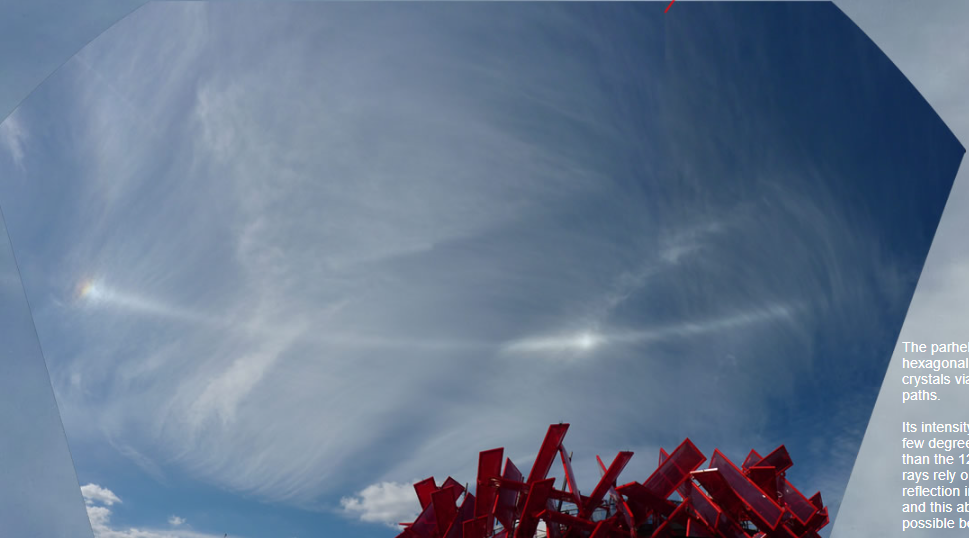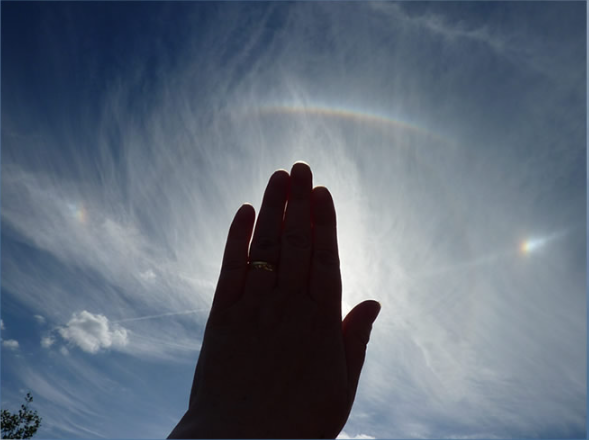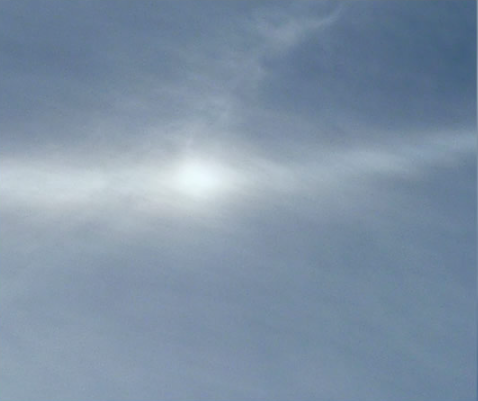OPOD - London Paralympic Halos
OPOD - London Paralympic Halos
At the London Paralympics on August 31, 2012, an enchanting display of atmospheric optics phenomena captured the attention of spectators. Katie Mortlock managed to photograph a bright sundog, parhelic circle, and a 120° parhelion. These stunning images showcased the beauty and complexity of halos formed by ice crystals in the high cirrus clouds.
Cirrus clouds, composed of ice crystals, can be found in various regions and seasons across the globe. These ice crystals play a crucial role in the formation of halos, creating mesmerizing optical effects in the sky.
The vibrant sundog captured in Mortlock's photograph was generated by horizontal plate crystals. When sunlight enters a near-vertical side face of these crystals and exits through another inclined face at an angle of approximately 60° to the first, it produces this colorful phenomenon. Sundogs are a common occurrence in areas with cirrus clouds and are often seen as bright spots of light on either side of the Sun.
The same horizontal plate crystals responsible for the sundog also contribute to the formation of a colorless parhelion at a distance of 120° around the parhelic circle. In this optical phenomenon, sunlight enters a top face of the crystal, undergoes two internal reflections, and then exits through the bottom face. The angles of entry and exit are equal and opposite, resulting in no net dispersion into colors. Essentially, observing a parhelion is akin to looking through a plate glass window.
The parhelic circle, another awe-inspiring feature captured in Mortlock's photographs, is produced by hexagonal plate and column crystals. The intricate structure of these crystals gives rise to numerous ray paths that contribute to the formation of the parhelic circle. However, its intensity diminishes slightly a few degrees farther from the Sun than the 120° parhelion. This decrease in intensity is due to the limitations of total internal reflection within the ice crystals, which becomes impossible beyond a critical angle.
Interestingly, the parhelic circle even intersects with the Sun itself, as evident from the fragment of the circumscribed halo seen above the Sun in one of the images. This indicates the presence of horizontal column crystals alongside the plates. The combination of these crystal shapes adds to the complexity and visual appeal of the atmospheric optics display.
While the 120° parhelion lacks vibrant colors, it can still be challenging to spot against a cloudy backdrop. However, if observed carefully, both the parhelion and the parhelic circle may exhibit faint corona-like diffraction colors along their edges. The occurrence of a bright 120° parhelion is relatively uncommon, as it requires thick or non-regular hexagonal plates to generate such a striking optical effect.
The London Paralympics Halos serve as a reminder of the intricate beauty present in our atmosphere. The interplay between sunlight and ice crystals in cirrus clouds creates a captivating visual spectacle for those lucky enough to witness it. By appreciating and understanding these atmospheric optics phenomena, we can gain a deeper appreciation for the wonders that surround us, even in the seemingly ordinary clouds above.

London Paralympics Halos
Katie Mortlock caught this bright sundog (left), parhelic circle and 120° parhelion at the London Paralympics 31st Aug '12. The red panels belong to the Beat Box, an interactive sound pavilion. More images below.
Images ©Katie Mortlock

Ice crystals in the high cirrus produced the halos. Cirrus is composed of ice crystals at all seasons and places on the planet.
The colourful sundog was made by horizontal plate crystals. Sun rays enter a near vertical side face and exit through another inclined 60° to the first.
The same crystals generated the colourless parhelion 120° around the parhelic circle from the sun. In the ray path shown, rays enter a top face then reflect twice internally before leaving through the bottom face. The entrance and exit angles are equal and opposite so there is no net dispersion into colours - take away the internal reflections and the path is equivalent to looking through a plate glass window.

The parhelic circle is produced by hexagonal plate and column crystals via a great many ray paths.
Its intensity suddenly lessens a few degrees farther from the sun than the 120° parhelion. Many rays rely on total internal reflection inside the ice crystals and this abruptly ceases to be possible beyond a critical angle.

The parhelic circle passed through the sun. The fragment of circumscribed halo above the sun shows that horizontal column crystals were present as well as plates.

The absence of colour makes the 120° parhelion difficult to spot against cloud although both it and the parhelic circle can be edged by faint corona type diffraction colours . The 120° parhelion is not common because thick or non regular hexagonal plates are needed to give bright ones.
Note: this article has been automatically converted from the old site and may not appear as intended. You can find the original article here.
Reference Atmospheric Optics
If you use any of the definitions, information, or data presented on Atmospheric Optics, please copy the link or reference below to properly credit us as the reference source. Thank you!
-
<a href="https://atoptics.co.uk/blog/opod-london-paralympic-halos/">OPOD - London Paralympic Halos</a>
-
"OPOD - London Paralympic Halos". Atmospheric Optics. Accessed on November 26, 2024. https://atoptics.co.uk/blog/opod-london-paralympic-halos/.
-
"OPOD - London Paralympic Halos". Atmospheric Optics, https://atoptics.co.uk/blog/opod-london-paralympic-halos/. Accessed 26 November, 2024
-
OPOD - London Paralympic Halos. Atmospheric Optics. Retrieved from https://atoptics.co.uk/blog/opod-london-paralympic-halos/.